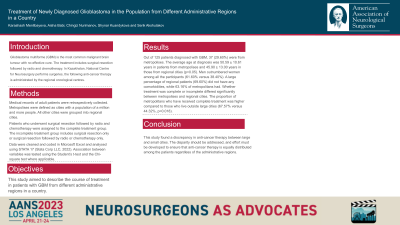Treatment of Newly Diagnosed Glioblastoma in the Population from Different Administrative Regions in a Country
Friday, April 21, 2023


Karashash Menlibayeva, MPH (she/her/hers)
Head of Hospital Management Department
National Centre for Neurosurgery
ePoster Presenter(s)
Introduction: Glioblastoma multiforme (GBM) is the most common malignant brain tumour with no effective cure. The treatment includes surgical resection followed by radio and chemotherapy. In Kazakhstan, National Centre for Neurosurgery performs surgeries, the following anti-cancer therapy is administrated by the regional oncological centres. This study aimed to describe the course of treatment in patients with GBM from different administrative regions in a country.
Methods: Medical records of adult patients were retrospectively collected. Metropolises were defined as cities with a population of a million and more people. All other cities were grouped into regional cities.
Patients who underwent surgical resection followed by radio and chemotherapy were assigned to the complete treatment group. The incomplete treatment group includes surgical resection only or surgical resection followed by radio or chemotherapy only.
Data were cleaned and coded in Microsoft Excel and analysed using STATA 17 (Stata Corp LLC, 2022). Association between variables was tested using the Student’s t-test and the Chi-square test where applicable.
Results: Out of 125 patients diagnosed with GBM, 37 (29.60%) were from metropolises. The average age at diagnosis was 50.59 ± 10.61 years in patients from metropolises and 45.90 ± 13.00 years in those from regional cities (p=0.05). Men outnumbered women among all the participants (61.60% versus 38.40%). A large percentage of regional patients (69.60%) did not have any comorbidities, while 63.16% of metropolitans had. Whether treatment was complete or incomplete differed significantly between metropolises and regional cities. The proportion of metropolitans who have received complete treatment was higher compared to those who live outside large cities (67.57% versus 44.32%, p=0.018).
Conclusion : This study found a discrepancy in anti-cancer therapy between large and small cities. The disparity should be addressed, and effort must be developed to ensure that anti-cancer therapy is equally distributed among the patients regardless of the administrative regions.
Methods: Medical records of adult patients were retrospectively collected. Metropolises were defined as cities with a population of a million and more people. All other cities were grouped into regional cities.
Patients who underwent surgical resection followed by radio and chemotherapy were assigned to the complete treatment group. The incomplete treatment group includes surgical resection only or surgical resection followed by radio or chemotherapy only.
Data were cleaned and coded in Microsoft Excel and analysed using STATA 17 (Stata Corp LLC, 2022). Association between variables was tested using the Student’s t-test and the Chi-square test where applicable.
Results: Out of 125 patients diagnosed with GBM, 37 (29.60%) were from metropolises. The average age at diagnosis was 50.59 ± 10.61 years in patients from metropolises and 45.90 ± 13.00 years in those from regional cities (p=0.05). Men outnumbered women among all the participants (61.60% versus 38.40%). A large percentage of regional patients (69.60%) did not have any comorbidities, while 63.16% of metropolitans had. Whether treatment was complete or incomplete differed significantly between metropolises and regional cities. The proportion of metropolitans who have received complete treatment was higher compared to those who live outside large cities (67.57% versus 44.32%, p=0.018).
Conclusion : This study found a discrepancy in anti-cancer therapy between large and small cities. The disparity should be addressed, and effort must be developed to ensure that anti-cancer therapy is equally distributed among the patients regardless of the administrative regions.
